|
|
|
click here to download file for Movie Script "SO ALONE"
click here to download file
Team of proud American Marine veterans
honor their lost buddies, and all Americans, who died in Vietnam, by having a Vietnamese peasant-farming refugee village
'Duc Duc' remembered. (Don Eiferd,
Dennis Sherman, George Dros, Fred Peterson, Richard Thomas, Bill Nimmo, Ronnie Armando Ponton, Jon Jones, Mike Smith,
John "Jack" Cunningham, Auxiliary
Supporter Alan Waugh [England]) Congressman Scott Garrett's of New Jersey is reviewing a request for a Congressional
Resolution to remember the sacrifices of the Duc Duc Refugee Village in their supporting U.S. Marines during the Vietnam. Recently, a special congressional investigation committee reviewed the details
of the Duc Duc Resettlement Village massacre. Although the massacre happened over 45 years ago, the details found
out about this massacre by this special congressional investigation committee can not be
released to the general public. Although
the details of this committee investigation of the Duc Duc Resettlement Village massacre can not be released to the
general public, Congress Scott Garrett's staff are still reviewing, if a Congressional Resolution dedicated to the People
of Duc Duc can be made.
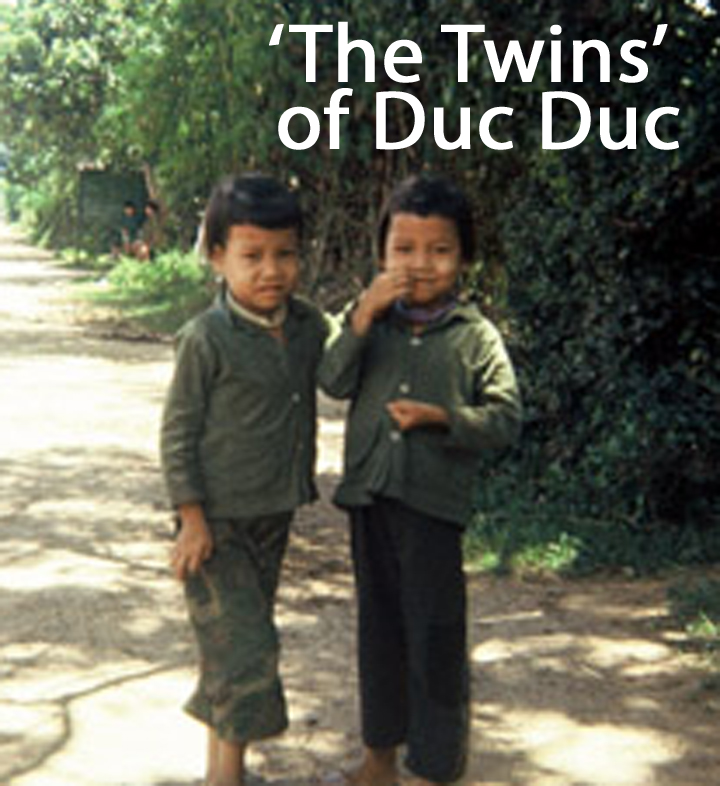
click here to download file for Movie Script "SO ALONE"
Robert Pierce Died Defending The Village
Of Duc Duc On August 11, 1970. Robert died while rushing
to aid another Marine Donnie Asbury, who also died that day.
(Seven months before Duc Duc was turned to ashes) It's 'Real Reasons' like the 'Duc Duc Refugee
Village' that over 58,000 American names are on 'The Wall' in Washington DC. Aerial View of the 'Duc Duc Refugee Village'
Before It Became Total Ashes
click here to download file for Movie Script "SO ALONE"
Below is the Military Map of the Above Aerial View
Below is a picture of what is left of Duc Duc after the communists punished the
village. "I think it was an all-out assault on the refugee
village of Duc Duc to demonstrate to other peasants in the area what would happen to them who resisted future communist
demands." John "Jack" Cunningham The below article highlights
that a communist prisoner said that his unit was forced march for three days without a rest in order to attack when they did.
The communist leadership wanted and planned well that the attack started on March 29th for a good reason.
WHY WERE THESE PEOPLE PUNISHED... 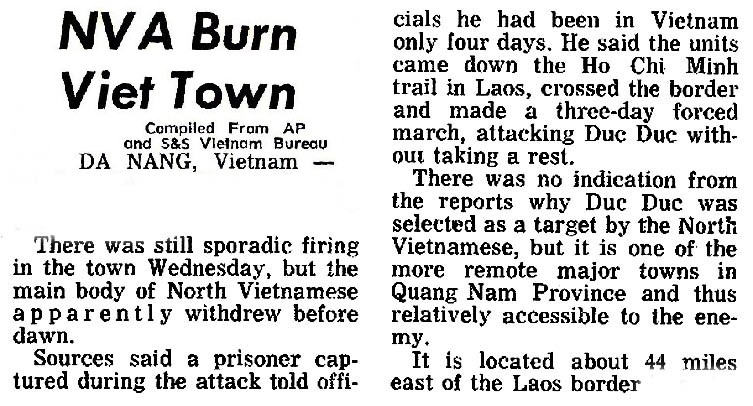 The first two weeks of March 1971 saw an increase in enemy
activity in the province of Quang Nam. Da Nang took 16 rockets in an attack on 4th March. Throughout the An Hoa basin patrols
made contact with small groups of VC or NVA. III MAF using recovered enemy documents knew that the Communists were planning a new offensive called the K-850 Campaign.
The objectives of the campaign were to attack district Headquarters, PF & RF positions, CUPP and CAP units. Da Nang would
also get its fair share of rockets . During K-850 the VC/NVA put a lot of pressure on the Vietnamese forces and their pacification programme. On 27th
March the 1st Marine Division put all its units on alert against foreseen rocket attacks. On the night of the 28th Da Nang
which was shrouded in low cloud came under rocket attack along with nearby allied positions. In the province the enemy attacked Duc Duc, Dai Loc, Dien
Ban, and the Que Son District Headquarters. They also attacked CUPP and CAP hamlets and refugee resettlement hamlets. Bridges
and highways in the province were also attacked. Early on the morning of the 29th at 0210 two battalions of the NVA 38th Regiment along with two VC sapper battalions
charged into Duc Duc while their mortars and rockets roared in. The District HQ compound was the NVA’s primary target.
Meanwhile the VC sappers attacked the nearby hamlets destroying everything in their path. The 412th Regional Force Company and the 123d Popular Force Platoon along with a few U.S. Advisers retreated to the
HQ Compound and prepared to make a last stand.The NVA encircled the compound and due to low cloud, fix-winged air support
could not be used. The defenders of the HQ could see the flames coming from local villages as the VC carried on with their
destruction. In Da Nang at 0245 the Direct Air Support Center ordered
the Black Hammer helicopters of 1st MAW stationed at Marble Mountain to fly to Duc Duc and assist its defenders. Black Hammer
was the name given to night reconnaissance missions. The patrol of helicopters was made up of a Huey searchlight bird from
HML-167 which was under the command of Captain Thomas C. Mc Donald who was the flight leader. With him were two AH-1Js Sea
Cobra gunships from HML-367. Lt Colonel Clifford E. Reese commanded these birds. Flying below the thick cloud with their running lights off, the choppers headed south-west towards Duc Duc which
was about 25 miles from Da Nang. Duc Duc incidentally was only a thousand meters from An Hoa Combat base. The U.S. Marines
had pulled out of An Hoa on the 15th of October 1970 leaving the base in the hands of the ARVN The burning villages acted
as a beacon for the Black Hammer patrol . The radio in the compound crackled into life as Captain McDonald contacted the U.S. Advisor. The advisor soon gave
a sitrep to McDonald and informed him that they were in grave danger of being overrun. Clearance was given for the gunships
to fire at any targets around the HQ’s perimeter. The advisor also told McDonald that he could not direct any air-strikes
as they were under heavy enemy fire. Mc Donald’s Huey lead the attack and the patrol dropped down to 400 feet and homed in on flashes from the enemy’s
guns. Once found the Huey’s Xenon search-lights lit up the area and a hail of bullets from the 7.62mm mini-guns and
20mm cannons tore into the NVA. The gunships also fired 2.75in rockets onto a knoll which was west of the compound where the
enemy had set up mortars and RPGs. The action was close and the gunships brought their firepower as near as 30 meters from the defenders. Desperate
times need desperate measures. Now the choppers were under attack as the NVA fired into the night sky. The search-light Huey
was most at risk. As soon as he turned on his beam, the NVA fired at it. The Black Hammer patrol stayed at Duc Duc for four hours. The AH-1Js took it in turns to fly back to Marble Mountain
to re-fuel and to re-arm. The other birds stayed to give cover to the trapped forces in the compound. The NVA then began to pull back towards the Song Thu Bon
and started to cross the river in boats. The Black Hammer followed this withdrawal and one of the Sea Cobras fired at the
boats, sinking six of them mid-stream. The NVA fired back at the birds and the Huey’s search-light operator was wounded.
With a Marine injured and the enemy in retreat the Black Hammer patrol returned to Marble Mountain and touched down at 0600.
During the battle the Black Hammer patrol had expended 2,800 rounds of 20mm cannon and 64 2.75in rockets. They also destroyed
6 boats and 12 hooches. The enemy KIA was four confirmed and ten probable. For the next three days and nights the area continued to take hostile fire. HML-367 squadron carried on with the
air cover and provided emergency medical envac. During the support of ARVN forces they expended 407 2.75in rockets, 14,158
rounds of 7.62mm and 1,386 rounds of 20mm ammunition. Units of the 51st ARVN Regiment were sent to reinforce the PF and RF garrison. They made contact with the NVA throughout
these three days. The NVA losses were 59 KIA while the RFs and PFs lost 20 men and 26 WIA. 103 civilians were murdered in
the attacked hamlets, 96 were injured and 37 civilians were also kidnapped by the NVA. Over 1,500 homes were destroyed by the VC sappers attack. The 38th Regiment remained
in the Duc Duc area and on the 3d April Duc Duc District HQ was attacked again by the NVA. Over 100 mortars fell on the compound
and surrounding villages. The NVA 38th Regiment was here to stay and take on the ARVN 51st.
ANOTHER EYE WITNESS REPORT OF THE MASSACRE I
was sent to Duc Duc in late January 1971 to be the "Senior NCO of the Marine Liaison Team."
The team consisted of me, the new guy, two Marine Lance Corporals, who had been there for a while,
and really could have done everything that needed to be done by themselves. I lived in a little hooch just to the right of where the U.S. Army put a generator
on the river side of the compound North (?). Right behind the building that had "Quan
Duc Duc" on it. I read the account
that the Marine helicopter pilots wrote that is on your website. That was the first I knew about the
boats and the NVA battalions. I was told later by the Army Intelligence Captain, who was part of Advisory
Team 15, that it was elements of the T-89th and 90th Sapper Battalions that had hit us.
We had been getting shelled on a fairly regular basis, but nothing
super-heavy. I was in the main bunker listening to RFVN about 0230-0300 hrs and they were
just reporting that Lt. Calley had been sentenced. We started taking pretty heavy mortar fire.
It hit the bunker that I was in and the building behind it. The second mortar round that hit the
building took out most of our medical supplies, including the IV bottles. A Rocket-Propelled-Grenade (RPG)
hit the chain link fence that the Army had put outside the bunkers for just this purpose, but the
explosion still pushed through the bunker wall and I got hit in the head with a PRC Radio that I
was trying to talk on. We were on the radio pretty quick and found out that the Viet Cong
terrorists were hitting several places all at once; so the cavalry so to speak, was spread thin.
A mortar round hit the roof of the bunker and the ply board
ceiling came down. The Vietnamese Commanding Officer, Major Chin, came in very excited and
yelled "VC in compound." An American Army Officer and I took an M-60 machine-gun
and headed for another bunker. We could see that most of the bunkers below us on the west side of the compound
had been satchel charged and were gone. We opened up with the M-60 just to let the Viet Cong
know we were there and they promptly returned the favor and wounded the Army Officer in the
arm. We could hear explosions all over, but I could not see what was happening on the village
side of the perimeter. We were the only folks on the west side of the defensive perimeter
for a while, and finally a Vietnamese machine gunner came over and opened up on our side with us.
After what seemed like an eternity,
black hammer helicopters showed up and began to lay down some fire and things began to calm down
on the west side of the perimeter. When the sun came up, I was able to get over to the south side towards
the former 5th Marine Base at An Hoa and could see that the village was a wreck. The hooches were
mostly burned down and there was a VC flag flying over the big blue building. There were
a few houses left, which were very close to the road that went from the compound out towards An
Hoa. We had helicopter support and they were shooting and buzzing
around the village. Some of the South Vietnamese troops moved out to take back
the village areas that the Viet Cong terrorists were still holding. We began trying to evacuate the wounded. I can't tell
you how many wounded there were, but they were being taken out on Ch-46 helicopters. Old Vietnamese
and young Vietnamese kept coming out of their burned village. The sight that will always stick
in my mind was a little two or three year old boy lying on the ground with a huge bandage around his little
head and it was soaked with blood. His eyes looked up at me and they were going back and forth like a metronome.
We were evacuating wounded villagers as fast as possible, but more would come. An old Vietnamese peasant was being carried on a bloody sheet
by his family, little kids and some women. There was a lot of blood and death and destruction
all around. I couldn't
figure out what the terrorists' military objective was. The Viet Cong put up a flag in the village
and they hammered us, but they must have known they weren't going to be able to hold it.
We had a lot of dead in the compound and in the village. Most of the village was gone, and
I don't know how many villagers were casualties. We got their flag from the village and
weapons from 33 KIA's. It took several days of evacuating wounded and picking up bodies.
My ears rang for more than a day. They had to send in a Navy ordinance disposal team to pick up all
the unexploded grenades etc. that were lying around from an ammo bunker they blew up. The U.S. Army Officer, who was wounded, received a Purple Heart
and I think may have been recommended for a Silver Star. (He had only 13 days to go on his
tour.) I was put in for a Bronze Star by the same Army Officer (The Army was easily
impressed by Marines.) The Marine Corps sent in a lot of
wood and tin to rebuild the village. About two weeks later, I was pulled out of Duc Duc and
I was sent to Hill 37. After that I was sent to Hill 42 and eventually was sent home.
What makes this massacre a nice, Vietnam War puzzle-piece is its timing. The communist high command wanted the massacre to be hidden from the American nightly news.
These are the two biggest news stories on the day of the Duc Duc Refugee Village Massacre.
March 29 - William Calley is found guilty of 22 murders in My Lai massacre and sentenced to life in prison. He
is later pardoned.
March 29 - A Los Angeles, California jury recommends the death penalty for Charles Manson
and three female followers.
It was also the period, when John Kerry was appearing on television and radio news
shows condemning American men and women, who were fighting for the freedom of the Vietnamese People.
At the time, the American News Media was portraying America's military as village burners
and much worse...
In the end, the American news media gave the
Vietnamese communist leadership pretty much what they wanted. The only reports were: CBC Evening News for Wednesday, Mar 31, 1971 - REPORTER: Walter
Cronkite
Saigon announces North Vietnam attacked Duc Duc, South Vietnam, last Sunday; killed 200 civilians.
NBC Evening News for Wednesday, Mar 31, 1971 - REPORTER: Frank Mcgee
North Vietnam attacks Duc Duc, South
Vietnam, killing or wounding over 200.
ABC Evening News for Wednesday, Mar 31, 1971 - REPORTER: Harry Reasoner
North Vietnam forces attack Duc Duc, South Vietnam, killing 100 civilians.
CBS Evening News for Friday, Apr 02,
1971 Headline: South Vietnam / Duc Duc
(Duc Duc, South Vietnam) Film shows destroyed village, civilians digging through
rubble; 107 known dead, 135 evacuated for treatment; villagers feel South Vietnam didn't help enough to prevent North
Vietnam attack.
[ Eyewritness to the attack: Major Franklin TRAPNELL - says heard news
of Calley conviction at same time enemy killing civilians at Duc Duc; says this another My Lai perpetuated by enemy this
time, with more killed for far less reason; hopes will have some impact on public.] US providing supplies to rebuild village.
REPORTER: Jeff Williams The American news media ended the coverage of the Duc Duc Massacre there.
No American students ever heard about the massacre in their school history books. But the My Lai Massacre, they did...
America as a whole heard about the My Lai Massacre often in the TV news and in news print. It's all over the internet
as well. Do a quick internet check on the Duc Duc Massacre. A side from the websites posted by CAP Marine John
"Jack" Cunningham, Duc Duc massacre is not mentioned in any detail.
click here to download file for Movie Script "SO ALONE"
|
 |
 |
 |
click here to download file for Movie Script "SO ALONE"
 |
|
|
Read the movie script about living and serving
(24/7) in the Duc Duc Refugee Village
ISIS’s Atrocities
In The Middle East Recall Viet Cong’s 1971 Duc Duc Massacre
Were the brutal terror tactics unleashed by the North
Vietnamese Communists and their Viet Cong allies during the Vietnam War a precursor
to the tactics used today by the Islamic State in the Middle
East?
A number of Vietnam veterans think
so, and they’ve been waging a little-known campaign to get the
U.S. government to recognize
a March 29, 1971, atrocity committed by the North Vietnamese Army and Viet Cong guerrillas
when they burned down 800 village homes, many with
the inhabitants huddling inside. At least 250 men, women and
children were wounded or killed. The mass incineration of the village of Duc Duc was
never recognized as a war crime like the My Lai massacre
in which U.S. Army Lt. William Calley was convicted of killing 22 Vietnamese
villagers. Calley’s life sentence was announced the same
day the communists attacked Duc Duc. “I thought Duc Duc represented
My Lai. Everything was so
one-sided in the media,” recalled former
Marine Lance Cpl. Jack Cunningham to The Daily Caller News Foundation’s
Investigative Group. He lived with the people of
Duc Duc as part of the Combined Action Program, which was dubbed
“the Peace Corps with Rifles.”
Cunningham has led a decades-long
campaign for official recognition of the Duc Duc atrocity and has compiled a series
of graphic, first-hand websites that portray life before and
after the massacre . The fires that burned
the Duc Duc homes were so bright on the night of the
attack, helicopter pilots 20 miles away in the
city of Danang could see the flames. “You
can see there’s a big empty space where the houses had
been. They were cardboard and tin houses. We called them hooches.
They were gone. Just burned,” Cunningham said. The Duc Duc village was a government-sponsored hamlet
that housed refugees who had fled Viet Cong-held areas. “There was no reason for them to set fire to the village,”
recalled Marine
Sgt. Dennis Sherman, who was stationed near Duc Duc. “There
was no military significance to the site. It was only
refugees. But it was a way to ‘convince’
people to move back to their area. The message was: ‘See, the government
can’t protect you from us,’” Sherman said. “The
Viet Cong hated them. The Viet Cong’s attitude was
‘it’s us or you’re dead,’” he said. “And that’s the way ISIS is today,” former
Marine Lance Cpl. Richard Thomas told TheDCNF. Thomas was
stationed three miles away from Duc Duc. Both
the American media and anti-war activists, however, largely ignored
communist atrocities and even praised the communists as good people. The late anti-war activist Tom Hayden
wrote in the Los Angeles Times in January
2013 that “far from being faceless fanatics,
the Vietnamese I met struck me as patriotic.” But the Vietnam vets continue to raise their politically
incorrect message that the U.S. government should
regard the burning of Duc Duc as an atrocity. Many
of the G.I.s see a similarity to the tactics used
by ISIS, whose guerrillas have beheaded, burned alive and hacked
to death civilians who don’t support them. “The Viet Cong would
hack people to death with machetes and bayonets. It’s
kind of like the way ISIS is doing right now,” said
Thomas. “The Viet
Cong were known for going into a village, grabbing somebody’s parents, shooting
one in the head and saying, ‘if you want
mom alive, cooperate with us,’” recalled Sherman. “That’s
how they operated.” On the night
of March 29, 1971, between 1,500 to 2,400 North Vietnamese
Army regulars and Viet Cong guerrillas launched their
assault on Duc Duc and on the nearby military base called the Fifth
Marine Combat Base. The
attackers poured through two perimeters and overwhelmed the
defenders — 150 ill-trained South Vietnamese
soldiers and 11 American soldiers. “There were
probably 150 people against a minimum of 1,500 enemy.
We were greatly outnumbered,” recalled Sherman who was on the
base when the attack started and later received a Bronze Star
for bravery. With
the troops preoccupied, the Vietnamese communists turned their attention
to the defenseless people of Duc Duc.
When the fires ebbed, a Viet Cong flag flew on top of one
standing building. The
village was destroyed and never rebuilt. The survivors
retreated further toward U.S. lines, but their whereabouts after
the fall of South Vietnam in 1975 are largely unknown. Noted Vietnam historian Robert Turner
told TheDCNF that for the Viet Cong, “brutality was a key to their strategy. They made no
distinction between combatants and noncombatants.”
The terror tactics were dictated by the North Vietnamese
Communist Party, which controlled the Viet Cong. “Most of the brutality
that I saw was because of official party policy, that is they were
doing something because this is something the party told them to do,” said
Turner, who also served in Vietnam. He is now a distinguished
fellow at the Center for National Security Law at the
University of Virginia School of Law. Descriptions of
ISIS operations against civilians in Iraq and Syria often
recall the communist atrocity in Duc Duc. “Survivors
describe an ISIS killing rampage whose main objective
was apparently to terrorize local
residents,” wrote Letta Tayler, a senior
terrorism researcher at Human Rights Watch, of the June 20, 2015,
assault on the Syrian City of Kobani. “By all accounts, this
was a planned attack on the civilian population
of this area.” That narrative differs
from actress Jane Fonda’s comments, who in a famous 1972 Radio
Hanoi broadcast while the war was in progress, lavished
praise on communist women fighters who sought to
kill American pilots. “I cherish
the memory of the blushing militia girls on the roof of their factory,
encouraging one of their sisters as she sang a song praising the blue
sky of Vietnam — these women, who are so gentle and
poetic, whose voices are so beautiful, but who, when American planes
are bombing their city, become such good fighters,” Fonda said. READ THE WHOLE STORY
AT: http://dailycaller.com/2016/12/12/isiss-atrocities-in-the-middle-east-recall-viet-congs-1971-duc-duc-massacre/
I found the following report from the 7th Marines Command Chronology dated March 4, 1968.
Although the grid coordinates are incorrect the village names are the same as those where
you served with CAP 2-9-2 (aka NOV 3). It seems like the massacre in
1971 was not
the first time the villagers had been brutalized.
Sandy Another CAP Marine
(d) 040500H:
Company I searched the area of (AT869571) and found 40 civilians KIA, 77
WIA, and 14 WIA (at this point there are several letters
I can't read ...Sandy
)
The villages of DUC DUC, PHU
DA, and AN HOA
had been mortared, and the enemy had moved through the
area burning huts and
throwing grenades at the civilians in their bomb shelters. The
Viet Cong terrorists told
civilians that the reason for the raid was to force the people to
return across
the river to the Arizona area
and grow rice.
Team of proud American Marine veterans
honor their lost buddies, and all Americans, who died in Vietnam, by having a
Vietnamese peasant-farming refugee village 'Duc Duc' remembered.(Don Eiferd, Dennis Sherman, George
Dros, Fred Peterson, Richard Thomas, Bill Nimmo, Ronnie
Armando Ponton, Jon Jones, Mike Smith,
John "Jack" Cunningham, Auxiliary Supporter Alan Waugh [England])
Congressman
Scott Garrett's of New Jersey is reviewing a request for a Congressional
Resolution to remember the sacrifices of the Duc Duc Refugee Village in their supporting U.S. Marines during the Vietnam. Recently, a special congressional investigation committee reviewed the details
of the Duc Duc Resettlement Village massacre. Although the massacre
happened over 45 years ago, the details found out about this massacre by this
special congressional investigation committee can not be
released to the general public. Although
the details of this committee investigation of the Duc Duc Resettlement Village
massacre can not be released to the general public, Congress Scott Garrett's
staff are still reviewing, if a Congressional Resolution dedicated to the People
of Duc Duc can be made.
"How
do you ask a man to be the last man to die for a mistake?" John Kerry
April 22, 1971 - At the time of his statements before the
United States Congress, television news reporters and cameras, and Vietnamese Communist Negotiators in Paris, France,
John Kerry was still in the United States Navy.
Less
than a month after the massacre of the Duc Duc Refugee Village, Senator John Kerry
became a spokesperson and negotiator for the communist government in Vietnam. At the time, John Kerry
was an officer in the United States Navy. Sen. Kerry met with the Viet Cong government
to negotiate a peace settlement without the authorization of our government: "I have been to Paris. I have
talked with both delegations at the peace talks, that is to say the Democratic Republic
of Vietnam and the Provisional Revolutionary Government and of all eight of Madam Binh's
points it has been stated time and time again, and was stated by Senator Vance Hartke when
he returned from Paris, and it has been stated by many other officials of this Government, if the United States were to
set a date for withdrawal the prisoners of war would be returned." (Vietnam Veterans
Against the War Statement by John Kerry to the Senate Committee of Foreign Relations, April
23, 1971.) Additional details, and EYE-WITNESS REPORTS of the massacre can be found by pressing the narratives at the top left
of this webpage. The below picture is U.S. Marine John "Jack"
Cunningham in the village of Duc Duc, less than a year before the near 2,000 Vietnamese peasant homes were burned to ash.
Below is a picture of the last Americans to live and serve in
this village. About eight months after this picture was taken near 2,000 homes were ash. (Don Eiferd, George Dros and John "Jack" Cunningham are among the Marines
in this picture taken on August 13, 1970.)
Military Map of the An Hoa Valley
The 'Other War' in Vietnam 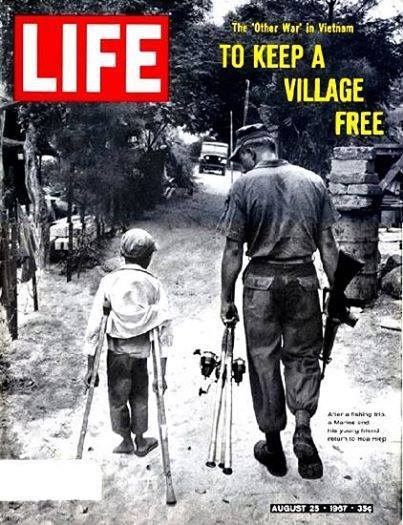 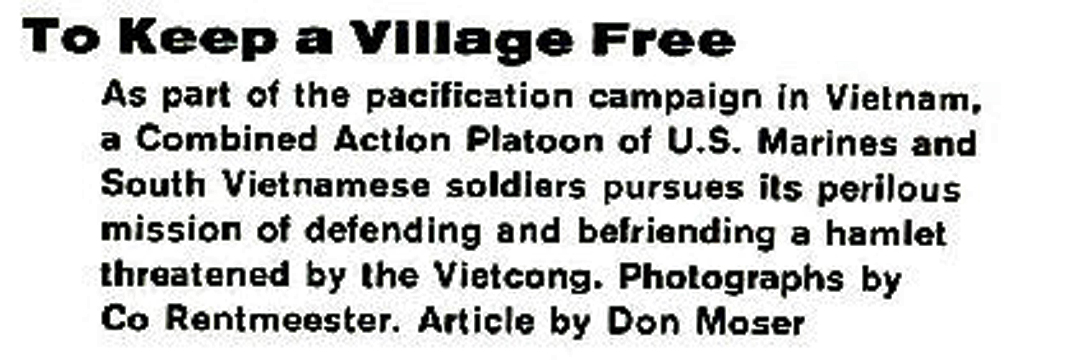 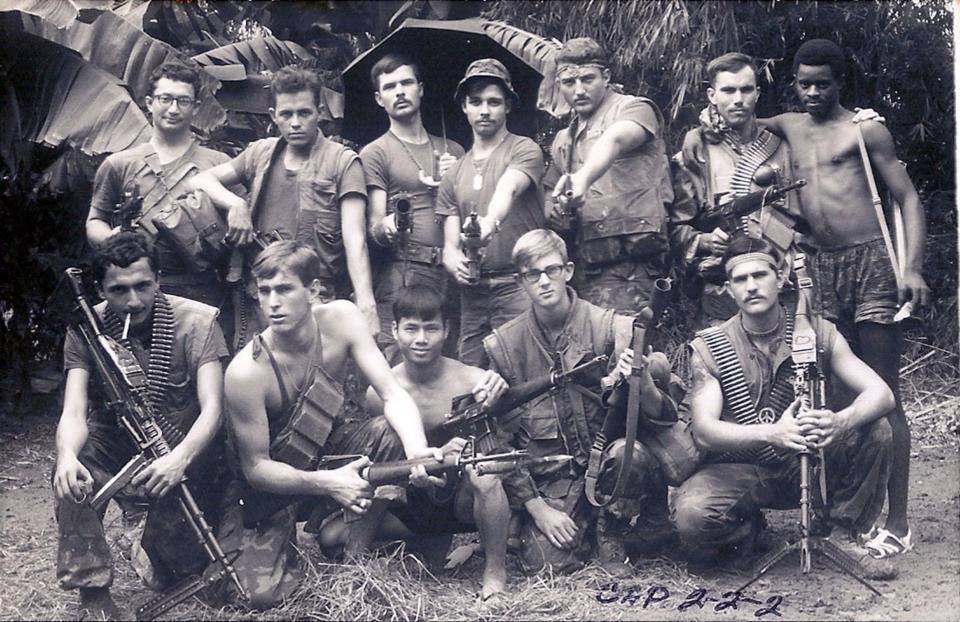 As the USMC Combined Action Platoons (CAP Teams) went fully mobile, many changes
occurred. They lived out in the villages on a 24/7 basis and as such had less reason to worry about stiff barracks
types checking them out. They didn't have a compound or a base to operate from, they selected
a different spot every day in one of the hamlets to hunker down for the day. At night
they split up and snuck into tactical positions around known VC routes. These were effective
rugged combat teams that lived "in and behind enemy lines all the time." As such
they developed individual and independent "looks" of identity. One time a Marine general commented that these
teams looked like a bunch of Chinese Warlords. This team, from CAP 2-2-2, in the area
west of Dai Loc obviously put on a show for this photos. But this is real and the men
in there are serious combat veterans of many ambush and patrols where contact with the
enemy occurred. This photo is from a well known CAP combat veteran Jack Cunningham whose combat reputation is beyond question. Jack is on the top row and is second from the right.
Semper Fi
|
|
 |
|